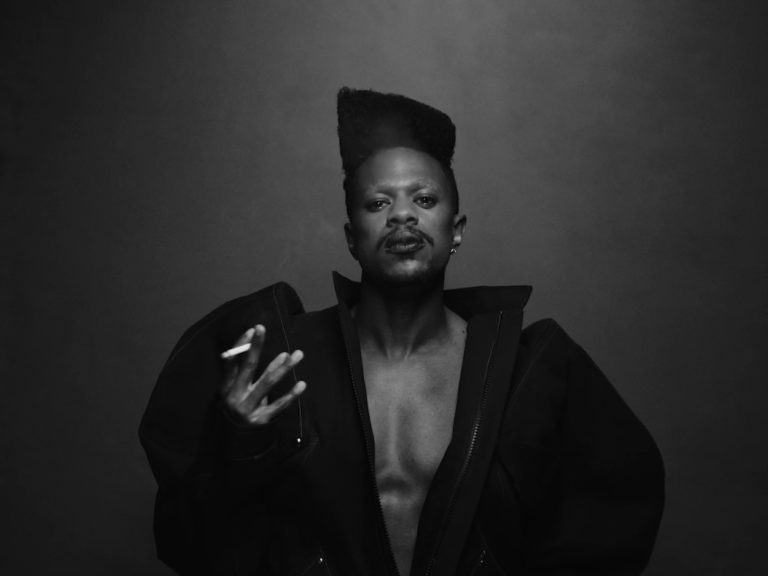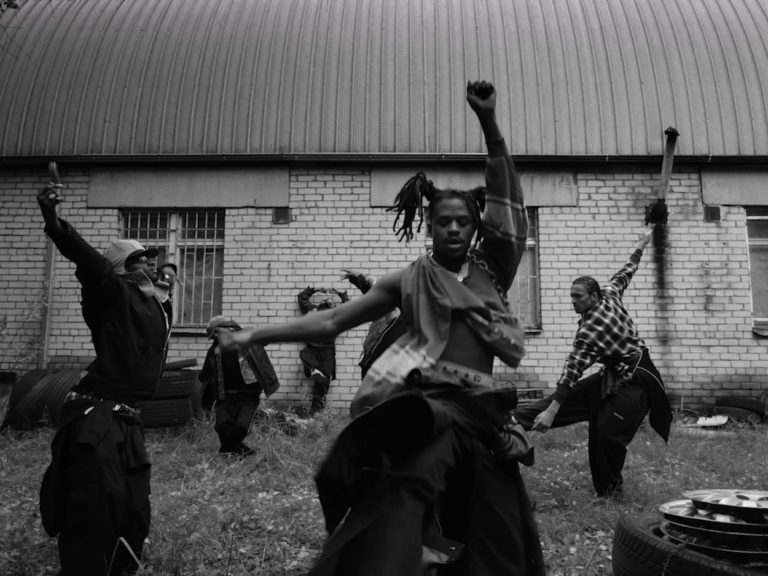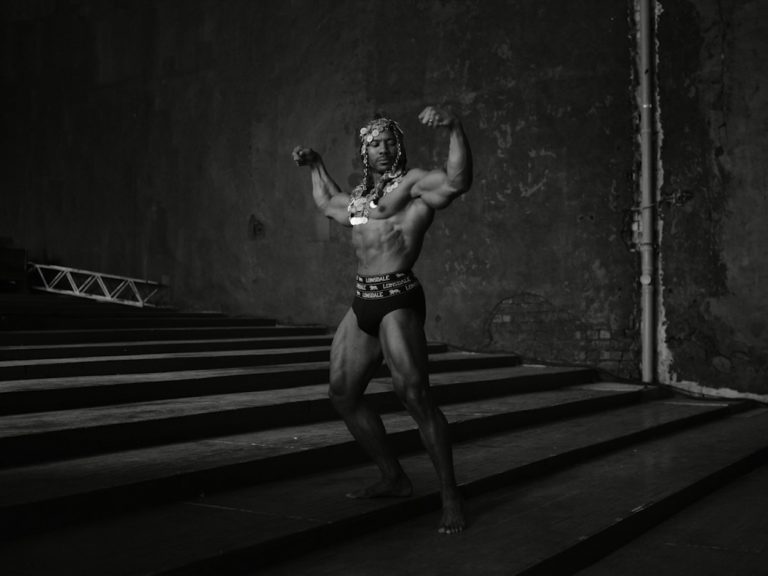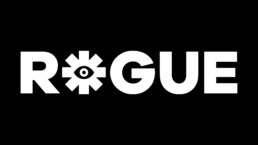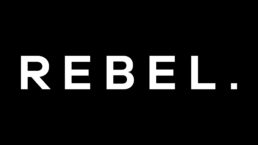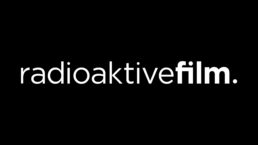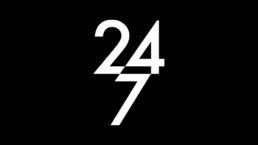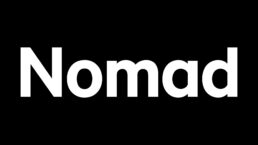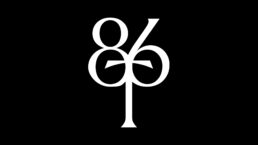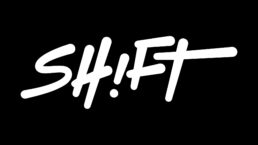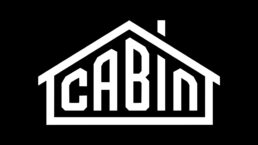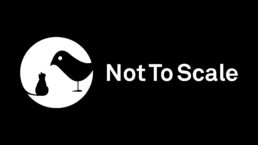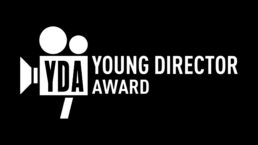Jeremy Pope and C Prinz in conversation at Tate Modern. Credit: Cassia Agyeman
This interview has been condensed and edited by 1.4 for clarity.
View the full film via the SMUGGLER website: GOD IS GOOD
Jason Okundaye: So first of all, Jeremy and C, do you want to introduce yourselves? I mean everyone knows you, but let’s give a little biography.
C Prinz: I feel like I know a lot of people here, it feels like family in the room, but if I don’t know you, thank you so much for coming. It means the world to both of us. We both haven’t watched it in a while and it feels like a time capsule to me. This is something that really was just born of discussions that we had late at night at a Panda Express, sobbing about parents and queerness and so much laughter.
Jeremy Pope: I’m Jeremy Pope. I’m five 11, Orlando, Florida. I’ll echo what C said. Growing up in Florida, my dad, who I love dearly, was a professional bodybuilder and a pastor. So I had a very extreme relationship to masculinity and how I’m supposed to present to the world, and being queer, I spent many years doubting myself and the ability to have a spiritual connection. I remember growing up it was all about learning the word of God to step into your purpose, but I kept feeling like, do I have a purpose? Or am I an abomination? So this film was an exploration of all of the scary things that little Jeremy thought, and that big Jeremy thinks. This film was healing, so that’s why I was just so overwhelmed to be on the other side of it. Sometimes it’s so hard to cross that finish line and get something made. We shot this a year ago in Latvia and in Estonia, which was incredible, and we had a very ambitious shooting schedule of four days. I am so grateful to everyone that had a hand in making this a real tangible thing because I am healed and changed forever by this experience.
JO: What I’ve really gotten from both of you is that there’s a real vulnerability in this project and that comes from queerness and that comes from experiences in the past. You kind of come to a journey of self-protection. For the two of you, in building this relationship and making this film, how did you manage that vulnerability and open up to each other to be able to create a project like this, which is so exposing and which is so emotional?
CP: Like anything really layered, it was just step by step. I think with creative endeavours with friends and family, you build relationships with people over time, and that it’s just a hard word to spell. We self-funded this piece with a lot of generosity from our chosen families here in the room tonight. There was a lot of blood, sweat and tears, and it was not always pretty. It was fucking freezing. And between us specifically, we were really honest. We always were. And that was the key – if we weren’t honest about the way that we felt every step of the way, the film would be very different. And I think we always were willing to see each other where we were at and love each other through my chaos and my finding of it and vice versa in all of the ways. But just step by step. You learn people and you love them every step of the way as much as you can.
JP: I have so much love for this human here. Get you a friend that only allows you to be the best version of yourself. C sees me, and it is a very vulnerable piece. Coming to her with this and saying, “this is what I think I want it to be”, and her “yes, and”-ing that was a dream. Originally this film was titled Blind Faith, that was one of our entry points. We were throwing out a lot of themes including this ability to shapeshift and blind faith – believing in the things you can’t see. There was something so powerful about that name, costume fitting Blind Faith, production Blind Faith, because it was a reminder to have that trust. There were a couple of moments where I didn’t have the money, team or location to make this film. But there was something about that blind faith and knowing that we were aligned and we were supposed to do this with the people that were supposed to be in the room. So I’m very, very, very grateful and I’m just so grateful to C because she really pushed me to bring in my theatre and singing and just all of the things that are Jeremy that I’d kind of pushed aside and she allowed me to be vulnerable. And I knew that she was going to have my back if I fell.
JO: Often with queer art, you can feel like it’s almost siloed as if it’s just about the blackness and queerness, while the discussion of the artistic process is sometimes missing. And I say that because this film, it’s not only beautiful for its themes, but it’s also artistically genius. At the start we have the flashes of blue, which I believe is a reference to Derek Jarman, and there are these incredible cultural references threaded throughout the film. So I wonder, what was the artistic process for both of you? Where were you drawing from in terms of art and literature and film?
JP: The thing that I love about working with C is we say we’re not going to make something unless we’re ready to scream it. So we do so much research. We take the time. We spent so many hours together looking through art books and trying to stay off the internet and Instagram, to find the root of real references. We were inspired by paintings, by textures, and we would sit and have hour long conversations about a Basquiat painting – I was on stage playing Basquiat when we were making this – so that was a big inspiration for me and him being an unconventional artist, but also so vulnerable and so visceral and so immediate. Digging deeper and deeper and unpacking these themes for myself was important. We have the flashes of blue and we have this duality between masculine and feminine energy. “Honour thy father and thy mother” was one of those commandments I remember, so it was like, what if I presented in this way? Am I still a child of God? I kind of look at life like an audition. Whether you do good or bad, you go to heaven or hell. That’s how it was put onto me growing up. So we wanted this audition of me presenting myself and working through all of these things in real time and in different versions of myself in mind and in heart. It was also super dope to go back to the early nineties, my first entry point to masculinity, Busta Rhymes, Biggie, Jay-Z, the way that the videos were shot, the way that the style was, and use that to inform the visual. And then also bringing in my COGIC Baptist background when the film needed it.
CP: My main reference for the structure of the film was the feeling of anxiety. I think Derek Jarman, and a lot of these other artists that we kind of tried to pay respect to, came later in the project in the edits and with other collaborators. The biggest reference for me was what it feels like to have a panic attack, how your brain is constantly interrupting itself – or at least mine does, it’s a nightmare. I also come from dance and live performance and staying really present in the body and listening to your body, and that was really the guiding light for the structure of the film for me.
JO: Obviously the film deals with very difficult and emotionally heavy themes, but it’s also funny and it’s not afraid to let itself go. You shake your ass, you make jokes, and I wonder what is the importance of humour for a project like this, and what’s the role that humour plays in your friendship as well?
JP: Well, for me, levity is the only way I’ve known to survive. I dunno if anyone’s ever been through some tough times, but you try to find the humour in it, that sliver of light. So I’ve come from a family that’s just funny. We cut up, we are literal certified clowns. We don’t know how to be serious. And C is the same way. It was important to make sure that the film had that sense of levity. I do wish that I could have had some of these harder conversations younger in life with my dad who was preaching to me from the pulpit and really not go so deep into my own homophobia. I’m still working my way out of it and it’s a process, but it was important to find that yin and yang and to shake your ass because that’s what we do on Friday, but we’d still be in church on Sunday and just keeping it above, you know? That is me. I love Kurt and I also love the City Girls. I could go both ways! So that felt important.
CP: I think also short films and anything in short form, any of us just out here funding photoshoots or making other short films or whatever it is, you pour your money into it and rally so many people around you and it feels like a lot of pressure and it’s very, very vulnerable and it’s hard and things don’t always go your way as you create. I watch this back and I’m happy there’s levity because we can’t always take it so serious. Like I said earlier, it’s really hitting me tonight that it’s like a time capsule. It reminds me of our late night conversations and where I was at with Marko, the stylist and Jill, the incredible producer, the conversations that we had in the making of this film. It’s like a timestamp in my brain, and it’s all these young kids just trying to create and submit to festivals and build our careers and hustle. It’s like us trying to be painters where you’re alone in your room. You wish you could just throw paint around, but for filmmakers it’s different. You have to be so vulnerable and get a bunch of cash and all this stuff. It’s fucking hard. And I think that this film is really showing an unveiling of the young artisan process and us finding our voices and trying to find each other as a new director, and (a way more established) actor together. This was my first more narrative piece, and I said to Jeremy the night before the film, I was like, I’m fucking scared, I come from dance! I’ve never worked with words. So yeah, it’s just a process, keep it light. It can be so heavy and feel so intense.
JO: Even though the film is drenched in black and white, the details of the costuming really come through. Particularly the contrast between Jeremy at your audition, a bit more stripped back compared to when you are walking into dry cleaners and you look absolutely fabulous. What was the creative process behind costuming and where to be more maximal and more minimal? What were you trying to communicate with the outfits?
JP: Shout out to the costume team who are here tonight, in fact please do talk! Let’s chat. We spent a lot of time building boards and having conversations about not just the look, but what can it mean, what can it say? Can it have dual meaning, this masculine, this feminine? They did such a beautiful, incredible job getting the pieces to Latvia, to Estonia, to wherever we needed it. Not only styling myself, but so many other beautiful talents and it was tough because we were working with a very limited budget, but we needed to look maximum on the screen. Shout out to all of the people that we were able to pull from. Marko, do please speak on it.
Marko Vrbos (Stylist): Yeah, just to get all these suitcases to Latvia was a mission. I think what Jeremy said, it was just a lot of back and forth and building boards. It wasn’t just, “what is it saying”, it was so personal to C, to Jeremy and to me as well, to talk about queerness. It wasn’t really dressing, we were bouncing off ideas and we did fittings and more fittings, and it was just a lot of back and forth until we got it. And an amazing team in London and in LA behind us.
JP: And what I learned through the process of this film and in life, is it’s okay to pivot. When you know better, you do better. Freeing yourself to that creatively is such a blessing, because we would have a fitting or see a look on the runway, and thought, that’s it. But we’d put it on and it wouldn’t feel right, the spirit didn’t move, and we said, okay, pivot. What time do we have? Can we do this? Give me that fabric, let me make this. And to be with creatives and collaborators that are okay to pivot to say, hey, this location doesn’t look right. Let’s go here. We only have an hour. Let’s shoot it this way. Everyone was in that space, and it allowed for this ebb and flow and for the film to reveal itself in real time. And that is a vulnerable thing because you’ve spent money and gotten flights and you’re like, y’all, we need to come back with something! But I think trusting the process is so important, from Blind Faith to God is Good, from styling to set to the edit. C went MIA for a good couple of days to piece together that initial monologue, and I was so moved that she was able to go in and find the edit, because I must have done that monologue 45 times as different characters on the day, which was so cool to play as an actor, to go through a process. I was a white woman at one point, with a little dialect. I was just trying it all. All of these characters and expressions were coming out of me. And then we got to sit in the edit and she showed me how we pieced it together. And it was so beautifully woven through.
CP: The monologue was supposed to be 2 minutes 22 seconds. That’s why the clock shows 2:22 the whole time. And then it turned into a 20 minute opus, and I was like, fuck. It became a completely different piece than what we flew there to shoot. We ask these people to fund these things and help us figure it out, and you come back with something so different and you get so nervous that they won’t like it. But I think what you said about pivoting is correct, like on set with the DP Mika, who challenged me to shoot the dance completely differently the night before. And Matilde, our wonderful AD, was down for the ride and Normans and all the locations team made it happen.
Audience question: Touching on the angel number of 2:22 on the clock, I noticed at the end it switched to 2:23, and I just wanted to ask about that decision that you made and having it be the final piece that turned over the clock.
JP: Yeah, I’m glad you picked that up. Yeah, 2:22, your number of alignment and purpose. The shift to 2:23 was me saying, don’t waste another minute. Don’t waste minutes stepping out of alignment, trying to prove yourself to other people. At the end of the film when I realise that I am a child of God, the organ plays right over it because it’s not for y’all, it’s for me. What you learn in this life, what you experience in this life is for you. Step into your purpose. There are people along the way who will champion you and see you and uplift you, but it’s your journey to your life, so learn and store. So it was just kind of a reminder to me and to the audience, please don’t waste another minute.
CP: I love what we found with your character up in the room. From the beginning, when he begins his audition, through this sort of letter to God, to the end when he returns to that upper room and he was asleep the whole time. Whether this whole film is a dream or whether it was just looking out a window, you can have these incredibly expansive conversations in your own mind. So, yes, look at everything that you are able to be in this one minute stretched into 20, and don’t waste a single one. I can see Robert, our bodybuilder, in the audience. He looks exactly like Pope’s father, the photo comparison was incredible.
JO: The kind of complexity of the project and its richness is incredibly striking, but of course you are approaching this not just as an actor, but also as a writer and also as a singer. And I wonder, how it was to be approaching this project on these three different fronts and also for C to interact with Jeremy across those aspects?
JP: First off, I had to get over the imposter syndrome. C was there to guide and to allow me to be a vessel as I wrote and spoke my truth. There was a particular scene that we knew had to be important, but what is it about? Who am I speaking to? So I started to just talk to myself and I realised that I had all these things written down in my journal, these open-ended questions to God from years back. Growing up in the church is very black or white. You’re not supposed to question the word of God. It is what it is. But what happens when you do have questions? Why is it so hard, God? And you listen and it’s silent. And my family saying you need to listen. You need to wait on God. So I’m looking at signs. I’m trying to find God in a person, in a thing, but are there even answers? Is there a right answer? Having a space to be able to just ask it, to propose it and to know that I’m not the only one with that question was a blessing.
I didn’t want the film to feel like blasphemy because I still have a connection with God. And I didn’t want people to think that I’m shitting on religion or God or having any type of spiritual connection. One thing that was really, really beautiful before we started shooting this monologue in the upper room, was that I had been told that there was no power in the building, but when I started to speak these words we suddenly had light.I didn’t know at the time, they didn’t really tell me. I thought they were doing some little lighting gag. But we had power. And I took that as a sign that we are aligned, we’re in the right place, and it’s okay. I felt the spirit there saying, it’s okay to say these things. You’re going to be a vessel for something bigger. You’re going to open up conversation for something bigger. And that’s what I wanted and needed this film to do for myself and hopefully for the audience.
JO: C, you’re dealing with three artists in one person. What’s the challenge with that as a director, particularly in terms of restraining as well? Because I guess there’s the tackle between the actor, the writer or the singer, and trying to balance all those different parts, especially when as a creative, he’s running wild. You want to do absolutely everything.
CP: I think I just try to run wild with it. I think the approach was “yes, and” to it all. One of the challenging things that we talked about was deciding how consistent we wanted the monologue to be, to keep a through line of the character. And then I think I felt the spirit move in me that we needed to let whatever comes out out. And you really did. I know that as an actor, you typically don’t have a lot of say in the edit, which is a really scary thing, so I really appreciate you trusting me, especially given I look so different from you, to use your body and your voice as a vessel. This film isn’t just about religion or being gay. It’s really just for anybody looking for hope. And that chaos was allowed to come out through movement, thanks to our choreographer Parris Goebel, and her amazing assistant Dez.
JO: I want to throw to the audience again. Anyone got any questions here in the front?
Audience Question: On letting go of control and surrendering, I wanted to know about the manifestation of desire. Do you feel like you guys released it through this film, allowing whatever the essence of spirit or nature just to come in?
JP: Yeah, I appreciate you saying that. When you prep as hard as we did, there is that buffer room to surrender because you’re like, we’ve done it all. We’ve researched, we’ve looked, we’ve thought, we’ve talked for hours and hours. So let’s have the blind faith. Let’s lean on our abilities, our strengths, the fact that we are unconventional, and our brilliant crew. I didn’t think we would be able to create something that was a hybrid for my music and as an actor. Coming from Broadway, I was fearful of combining music and film and distracting from the lyrics, but I think C and Amber, our beautiful editor, found a really nice way to combine everything.
Audience question: I also wanted to know about the symbolism in it and just allowing the audience to look at the symbolism and not idolise it or get distracted by it?
CP: This film was first intended to be in colour. And basically God bless Amber at Cabin Edit. I sat in that suite with them for 18 hours a day for too many days, and we had colour, then I brought in all these NASA royalty free imagery, adding more and more, with 27 different versions with different symbolic layers. And then I just realised I was trying too hard. In the end the fact that it is in black and white is what tied it all together. But everything we’re talking about, like you always say, is so grey. And Derek Jarman was the hero reference, rest in peace, an incredibly iconic gay artist who made a film called Blue, and it felt right that that was the only colour in the film, an artist who was true to himself and lost his life to AIDS. Colour really was the main symbolism thing for me.
JP: I really needed to see myself in a different light from this place of marginalisation. It was about reimagining these symbols, the church, the spirit, masculinity, femininity, what a black man can look like and exist as. So this film is like a marker for me because I’m not used to that freedom of expression. As an actor, to see myself and to explore all of the multi-facets, put myself in front of people is very vulnerable. But whenever I do peek at it, like this evening, I feel something completely different than when we made the film. So yeah, grateful for that.
Audience Question: How did you decide to shoot the film in Latvia?
CP: Because Normans is the MAN! My lovely EP at the time, Elizabeth Doonan from Smuggler, said, I know this guy in Eastern Europe and he’s so hungry for art. He seems really creative. And we had bid it out in New York and LA and it’s like a gazillion dollars and nothing made sense. And all of a sudden, this location book that came in, and it literally was like a message from God. Every location that we needed was right next door to each other. Except for the fact that we did go to Estonia, but we just had to do that. Sorry. But it felt like we had to go there and we had to do it there. And thank God we did because we made friends for life and we brought over our beautiful dancers. Such vessels, they worked so hard. There’s so much material that didn’t end up in this film. Maybe we’ll do a live performance version at some point. But yeah, thank you all so much.
Moderated by Jason Okundaye
INFO:
Reference material and unseen footage: https://godisgood.smugglersite.com/
C Prinz website
@cprinz__
@jeremypope
@jasebyjason
@smugglersite
@cassiaagy







